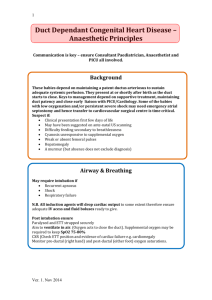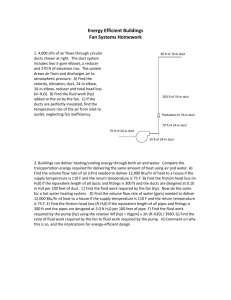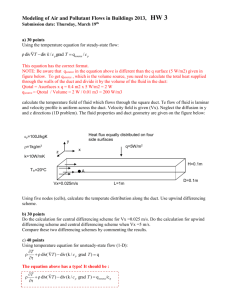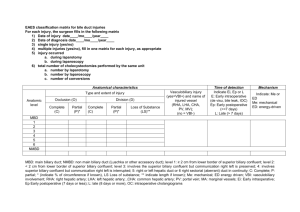Numerical Simulation of the Effect of a Flow
advertisement
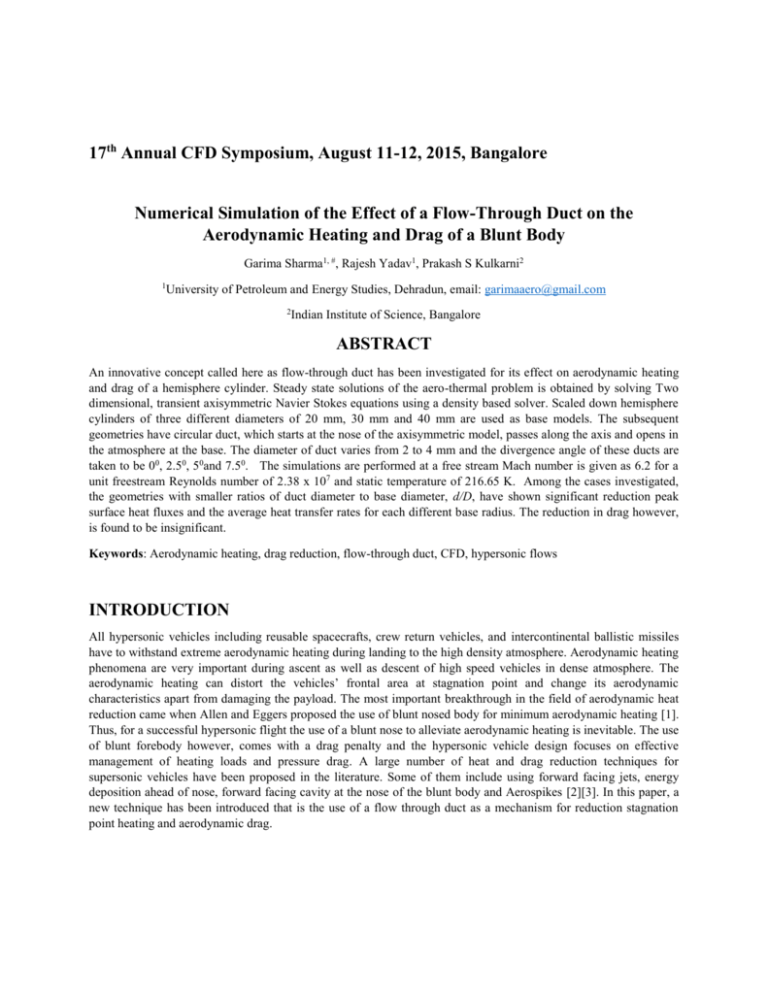
17th Annual CFD Symposium, August 11-12, 2015, Bangalore Numerical Simulation of the Effect of a Flow-Through Duct on the Aerodynamic Heating and Drag of a Blunt Body Garima Sharma1, #, Rajesh Yadav1, Prakash S Kulkarni2 1 University of Petroleum and Energy Studies, Dehradun, email: garimaaero@gmail.com 2 Indian Institute of Science, Bangalore ABSTRACT An innovative concept called here as flow-through duct has been investigated for its effect on aerodynamic heating and drag of a hemisphere cylinder. Steady state solutions of the aero-thermal problem is obtained by solving Two dimensional, transient axisymmetric Navier Stokes equations using a density based solver. Scaled down hemisphere cylinders of three different diameters of 20 mm, 30 mm and 40 mm are used as base models. The subsequent geometries have circular duct, which starts at the nose of the axisymmetric model, passes along the axis and opens in the atmosphere at the base. The diameter of duct varies from 2 to 4 mm and the divergence angle of these ducts are taken to be 00, 2.50, 50and 7.50. The simulations are performed at a free stream Mach number is given as 6.2 for a unit freestream Reynolds number of 2.38 x 107 and static temperature of 216.65 K. Among the cases investigated, the geometries with smaller ratios of duct diameter to base diameter, d/D, have shown significant reduction peak surface heat fluxes and the average heat transfer rates for each different base radius. The reduction in drag however, is found to be insignificant. Keywords: Aerodynamic heating, drag reduction, flow-through duct, CFD, hypersonic flows INTRODUCTION All hypersonic vehicles including reusable spacecrafts, crew return vehicles, and intercontinental ballistic missiles have to withstand extreme aerodynamic heating during landing to the high density atmosphere. Aerodynamic heating phenomena are very important during ascent as well as descent of high speed vehicles in dense atmosphere. The aerodynamic heating can distort the vehicles’ frontal area at stagnation point and change its aerodynamic characteristics apart from damaging the payload. The most important breakthrough in the field of aerodynamic heat reduction came when Allen and Eggers proposed the use of blunt nosed body for minimum aerodynamic heating [1]. Thus, for a successful hypersonic flight the use of a blunt nose to alleviate aerodynamic heating is inevitable. The use of blunt forebody however, comes with a drag penalty and the hypersonic vehicle design focuses on effective management of heating loads and pressure drag. A large number of heat and drag reduction techniques for supersonic vehicles have been proposed in the literature. Some of them include using forward facing jets, energy deposition ahead of nose, forward facing cavity at the nose of the blunt body and Aerospikes [2][3]. In this paper, a new technique has been introduced that is the use of a flow through duct as a mechanism for reduction stagnation point heating and aerodynamic drag. The Concept of Flow-Through Duct When high speed air encounters at the nose of blunt body, its velocity becomes zero at stagnation point. Because of large frontal area, along stagnation point, neighboring air molecules also slowed down drastically and forms stagnation region at the nose. At the stagnation point, all kinetic energy changes into thermal energy. This high temperature gives rise to the heat fluxes over the body. In the flow through duct concept, as the air passes through duct that joins the stagnation region to the base of the body along the longitudinal axis, holds some kinetic energy, and allows some passage for high speed air. Some investigations have shown that a channel can reduce the wave drag for airfoils at supersonic speeds [4]. This might also results in decrease the aerodynamic heating at the stagnation point [5]. The schematic diagram of the concept is as shown in Fig. 1. Fig.1: The Flow-through Concept Fig. 2: Mapped Mesh around ducted blunt body NUMERICAL METHODOLOGY The base model is a hemisphere cylinder with a base diameter of 40 mm, 60 mm and 80 mm and an overall length of 90mm. The subsequent models have flow through ducts of diameter 2, 3, 4 mm with divergence angle, θ of 00, 2.50, 50 and 7.50. For all these models, axisymmetric grids with mapped quadrilateral meshes are created with stretching in the radial direction as shown in Fig. 2. The starting mapped mesh for the base body has a total of 100,000 quadrilaterals with 500 cells along the body and 200 cells in radial direction. With the addition of ducts along the axis, the cell count for the subsequent geometries varies from 110,000 to 120,000 depending on the diameter of the duct and the divergence angle. In order to resolve the viscous stresses and fluxes the distance of the first cell from the body is kept to be 1 x 10-07 such that the non-dimensional cell-wall distance at the body, y+≃ 1. All results obtained in this paper are through time marching solution of the 2-dimesional, axisymmetric Navier stokes equations solved in a coupled manner using an implicit scheme. The solver marches in time with time step of 10-07 seconds and the steady state is assumed to have achieved when the body forces and the wall fluxes cease to change. The base model is a hemisphere cylinder with a base diameter of 40 mm, 60 mm and 80 mm and an overall length of 90mm. The subsequent models have flow through ducts of diameter 2, 3, 4 mm with divergence angle, θ of 00, 2.50, 50 and 7.50. For all these models, axisymmetric grids with mapped quadrilateral meshes are created with stretching in the radial direction as shown in Fig. 2. The starting mapped mesh for the base body has a total of 100,000 quadrilaterals with 500 cells along the body and 200 cells in radial direction. With the addition of ducts along the axis, the cell count for the subsequent geometries varies from 110,000 to 120,000 depending on the diameter of the duct and the divergence angle. In order to resolve the viscous stresses and fluxes the distance of the first cell from the body is kept to be 1 x 10-07 such that the non-dimensional cell-wall distance at the body, y+≃ 1. All results obtained in this paper are through time marching solution of the 2-dimesional, axisymmetric Navier stokes equations solved in a coupled manner using an implicit scheme. The commercially available robust NavierStokes solver FLUENT® has been used to obtain these solutions. The solver marches in time with time step of 10-07 seconds and the steady state is assumed to have achieved when the body forces and the wall fluxes cease to change. Geometric Modelling and Grid Independence Study All the two-dimensional geometric models and the axisymmetric grids are generated using the geometric modelling and mesh generation software Gambit. The base model is a hemisphere – cylinder with a base diameter of 40mm and an overall length 90mm. 36 models with flow through ducts are examined with the diameter of 2,4,6mm with divergence angle of 00, 2.50, 50 and 7.50. For all these models, axisymmetric grids with mapped quadrilateral meshes are created with an exponential stretching in the radial direction. For solving viscous and heating effects properly, very fine grid points is used near the wall of the body, with first cell distance of 1 x 10-7 m. For the base model, the solutions are obtained on a 411 x 200 grid with 82,200 quadrilaterals while the ducted configurations have cells up to 136000 based on duct configurations. A grid independence study is done to establish that these grids are sufficient to provide a grid independent solution as shown in Fig. 3. The grid refinement is done in solver itself based on the gradient of pressure and temperatures. Fig. 3: Pressure distribution over 3 mm duct with divergence angle of 2.5 o Temporal and Spatial Discretization The transient nature of the flow field is captured using second order accurate implicit scheme with dual time stepping. Initial guess for the flow field variables are obtained with the steady-state solution using local time stepping for faster convergence. In the dual time stepping, at each physical time step, internal iterations are performed based on the pseudo-time step based on the CFL number such that convergence is achieved at each time step. For all cases CFL number is kept as 1. The inviscid fluxes are computed using modified version of the Advection Upstream Splitting Method (AUSM). In this scheme, the addition of explicit artificial dissipation is avoided and this flux formulation provides very high resolution of the shock discontinuity and is free of Gibbs error. The viscous terms in the governing system of axisymmetric Navier-Stokes equations are discretized with second order central differencing. Turbulence Model All the simulations are performed at a free stream Reynolds number of 2.38 x 107 m-1 and thus the flow can be assumed to be turbulent and a suitable turbulence model needs to be implemented. The turbulence model implemented in this study is the modified version of the Spalart –Allmaras (SA) model which incorporates both the strain and vorticity based production. The SA model was designed specifically for aerospace applications involving wall bounded flows and has been validated for a wide range of hypersonic flows. The main advantage of using this model is the computational efficiency and insensitiveness to wall distance. This model accurately predicts wall bounded flows with adverse pressure gradients and is quite popular for hypersonic flow applications. Boundary Conditions For a cylindrical geometric at zero angles of attack the computational efforts can be drastically reduced by assumption of axisymmetric flows when a 2D mesh can be used for computation. An axis boundary condition has been implemented on the longitudinal axis of the hemisphere-cylinder in this problem across which the following conditions hold. The body of the hemisphere-cylinder is to be an isothermal wall at a temperature of 300 K with a no slip velocity condition for viscous flows (u=0, v=0). All other boundaries of the flow domain are assumed to be pressure far field with Mach number and static pressure and temperature specified. The details of free stream boundary conditions applied at the inlet are given in Table A. The variables at the outlet far field are obtained through interpolation from the interior of the domain. TABLE A Units Values Symbol Mach number M ------- 6.2 2 Pressure P N/m Temperature Molecular viscosity T µ K kg-m/s 216.65 1.7894e-05 Reynolds number Re m-1 2.38 x 107 ------- 2 Turbulent ratio viscosity 𝜇𝑇 ⁄𝜇 16066 RESULTS AND DISCUSSION The flowfield around a hemisphere-cylinder is well understood and results obtained are in line with that existing in the literature. Figure 4 (a) and (b) show the contours of Mach number for hemisphere-cylinder with a 3 mm straight and diverging ducts respectively. A choked flow can be seen in the contours with a sharp undistorted bow shock wave ahead of thr blunt body. The stagnation flow accelerates slightly through the duct to reach supersonic speeds but slows down and flow remains sonic throughout the duct. The flow expands after exiting the duct reaching high supersonic speeds close to freestream Mach numbers, terminated by a strong near normal concave shock. For diverging ducts however, the Mach number increases gradually through the duct to reach high supersonic values at the exit. Post exit, the flow expands slightly before being slowed down by series of compression waves. As the angle of divergence of the ducts increase the flow expands to freestream values well before the exit and terminated by oblique shcok wave to lower supersonic values before exit. The flow further expands and is recompressed by another obliques shock wave. As the angle increases the pocket of high temperature flow at the base reduces. The removal of the stagnation region and addition of passage for stagnant air effectively reduces the ammount of heat transferred to the nose of the blunt body. The peak surface heating, that occurs at the stagnation point for blunt body, is seen at the sharp leading edge of the duct inlet. This heating is however, not as severe as the stagnation heating and a reduction of about 28% can be see for 2 mm diameter duct. As the duct diameter increases for the peak heating at the lip also increases as can be seen in Fig. 5 (a) and (b). The heat fluxes in Figs. 5 (a) and (b) are nondimensionalized with the stagnation point heat transfer rate of the base hemisphere-cylinder without duct. Fig. 4 Contours of Mach numbers for a) 3 mm dia. straight duct and b) 3 mm dia. diverging duct with θ=2.5o With increase in duct divergence angle, an increase in loacl heating is seen for larger duct diameters. A slight relief in peak heating for large duct diameters is observed for higher divergence angles. For the configurations with 2 mm duct no change in peak heating with change in divergence angle can be seen. For all the cases investigated, a small reduction of upto 10%, in the area weighted average of surface heat fluxes also reduces, largely due to increase in wetted surface area of the body. The total integrated heat transfer rates to the hemisphere-cylinder is however unchanged by the presence of the duct. The aerodynamic drag of the hemisphere cylinder is also unchanged by the introduction of the flow-through duct. Though the pressure drag is seen to have reduced marginally, the additional skin friction adds off for it and hence no overall change in drag. Fig. 5 Variation of peak surface heating with a) duct divergence angle and b) duct diameter. CONCLUSION The paper presents the effect of adding a flow through duct along the longitudinal axis of a hemispherical cylinder. The duct diameter was varied from 2mm to 4mm in size and with divergence angles of 0o, 2.5o, 5o and 7.5o. Though a clear reduction in total heat transfer rates has not been observed, a substantial reduction in peak surface heat flux of up to 28%, is found for configurations with 2 mm diameter ducts. Also a small reduction of 10 % in the area weighted average of surface heat fluxes is observed. These reductions in area weighted average heat fluxes are independent of duct diameters and increases with increasing duct divergence angle. Any reduction in the aerodynamic drag has not been observed for the cases investigated. Thus, the flow through duct concept has been found to be effective in reducing the stagnation point heat transfer rate. REFERENCES 1. 2. 3. 4. 5. Allen, H. Julian, and A. J. Eggers. A study of the motion and aerodynamic heating of ballistic missiles entering the earth's atmosphere at high supersonic speeds. NACA, 1958.. Ogawa, Hideaki, and Holger Babinsky. "Evaluation of wave drag reduction by flow control." Aerospace science and technology 10.1 (2006): 1-8. Marley, Christopher D. A numerical study of novel drag reduction techniques for blunt bodies in hypersonic flows. MISSOURI UNIV OF SCIENCE AND TECHNOLOGY ROLLA, 2011. Ruffin, Stephen M., Anurag Gupta, and David Marshall. "Supersonic channel airfoils for reduced drag." AIAA journal 38.3 (2000): 480-486. Yadav, Rajesh, Gurunadh Velidi, and Ugur Guven. "AEROTHERMODYNAMICS OF A HEMISPHERICAL-CYLINDRICAL BLUNT VEHICLE WITH A FLOW THROUGH DUCT. 63rd International Astronautical Congress, Naples, Italy., IAC-12, C2,7,11x12904, pp. 1-8, 2012.

